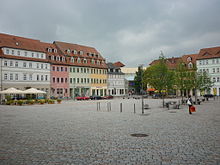Marketplace (Apolda)
The rectangular market square of Apolda is an urban ensemble in the old town of Apolda . It already existed in the 12th century and at that time was of central importance for the exchange of goods in the place and its surroundings. Today's picture is shaped by the town hall and houses from the 18th and 19th centuries. These houses stand out from the half-timbered houses in the former suburbs around the Martinskirche and the Lindenberg due to their massive and stately execution in the building fabric.
There are listed portals at the houses at No. 3, 4, 7, 10 and 12. At house number 12 - the Schuhmannschen house - the year 1741 has even been preserved. The massive ground floors survived the two city fires of 1763 and 1769.
Residential and commercial buildings
The house with the no. 4 is located on a piece of land that originally belonged to the Vitzthumen. It is characterized by a stately courtyard with a three-storey residential building, various ancillary courtyard buildings and a gateway building to the Topfmarkt. The ornate entrance portal indicates that the former owners were very wealthy. In 1779, house No. 7 started a major fire, and Johann Wolfgang von Goethe , who drew up the recruiting in the town hall that same year, also helped to fight it . In the fire, almost 100 houses were destroyed in the market, in Bachgasse (today Bachstrasse) and in Ritterstrasse.
The city pharmacy is located in house number 11. Its existence in this house has been documented since 1727. The building was given its present appearance after renovations in 1912. Schuhmannsche House No. 12 is one of the most representative town houses on the market square. After the major fire of 1779, two upper floors with spacious rooms were built on the massive ground floor and cross vaulted ceiling. In 1844, Apolda's first postal expedition was set up in this house. The dog breeders' association was founded in the neighboring house in 1863. The year 1769 can be seen on the entrance portal. The house has been rebuilt several times, has four floors and a courtyard with an exit to Ritterstraße. The Kirschbachsche House No. 19 has a classical facade design.
Fairs, pavements and loss of meaning
In the oldest city book, the "Red Book", which was created between 1430 and 1440 and contains the oldest written and preserved statutes of the city, the right to hold weekly markets and a fair (the Martini market) is already recorded.
The highlights of the year were the annual fairs. The Ulrichsmarkt was held in early July, the Martini market in November and the Lätaremarkt on the 4th Sunday after Ash Wednesday . From 1824 the wool market took place for a few years. Pigeon markets, cattle markets and junk markets were held until the 20th century. A specialty of Apolda is the dog market, which took place on the market for decades from 1863.
The paving of the market square in 1831 and 1874 had a positive effect on the use of the market. With the spatial expansion of the city in the 19th century and the construction of streets in the direction of the train station, the market lost its position as the center of the city center.
literature
- Kronfeld, Julius Constantin: History and description of the factory and trade town of Apolda and its immediate surroundings. Apolda 1871.
- Gollrad, Eva: History and description of the city of Apolda 1871–1990 , Apolda o. J., ISBN 3-00-002012-8
- Kulturbund der DDR, Kreisorganisation Apolda: 700 years of the city of Apolda - 1289 to 1989
Web links
Coordinates: 51 ° 1 ′ 21.7 ″ N , 11 ° 30 ′ 48.3 ″ E





